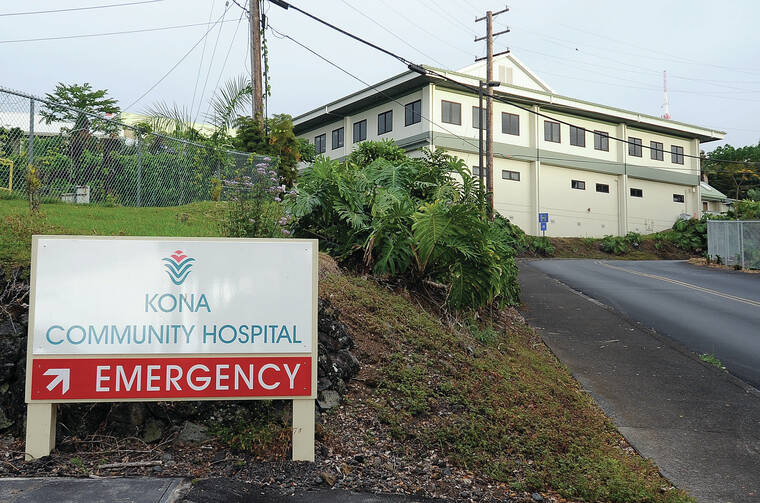‘How long will it take?’: Effort to secure new hospital for Kona renewed
By Laura Ruminski West Hawaii Today lruminski@westhawaiitoday.com | Monday, February 7, 2022, 12:05 a.m.

A bill in the state House to provide funding for a site assessment to find a viable location for a new hospital site in North Kona passed its first committee hearing Thursday.
House Bill 1638, introduced by Rep. Nicole Lowen (D-North Kona) seeks $1 million to identify and evaluate viable locations for a new hospital, a recurring endeavor brought up yearly in the Legislature.
Lowen said the site assessment is needed to lay the groundwork for building a new hospital in North Kona.
“We have to put one foot in front of the other,” she said. “If we don’t start talking about this now, how long will it take?”
Discussion about the need for a new hospital to serve residences in North and South Kona has been ongoing for nearly two decades. The area is currently served by the 94-bed Kona Community Hospital in Kealakekua, a Hawaii Health Systems Corp. facility constructed in 1974.
“The population in the Kona area has grown and migrated north since the hospital was built almost fifty years ago, so the hospital is no longer located in the area with the highest residential density and need for services. While the highway in North Kona has been expanded, the hospital in South Kona sits on a single-lane highway that is vulnerable to traffic congestion, making it difficult for emergency vehicles and others to reach the hospital quickly,” the proposed bill reads.
The bill further states a new, more modern facility can provide additional services, better access to Kona International Airport, which is nearly 20 miles from the current facility, for medical airlifts, and a more convenient location for the area’s residents. The new hospital would also serve as an attractive workplace and help the state recruit doctors and health care workers to fill the state’s critical need.
According to a November 2021 report submitted to the 2022 state Legislature, there are currently 10,592 physicians licensed to practice in Hawaii, but just 3,290 are actively providing patient care and provide 2,857 full-time equivalents of direct patient care. The number of full-time equivalents was up 45 over 2020.
The number of doctors, however, does not meet the state’s demand, according to the Hawaii Physician Workforce Assessment Project. Hawaii, according to a demand model based on U.S. average physician use, needs 3,395 full-time equivalents of practicing physicians.
“This indicates a shortage of 537 FTE of physician services. However, when island geography and unmet specialty specific needs by county are examined, the estimated unmet need for physicians (accounting for geographic distance and air travel) increases to 732 FTEs,” the report reads. “The demand model predicts our demand will increase by 38 FTE a year. If we only increase our workforce by 50 a year, we will not meet our demand in the foreseeable future.”
According to the report, Hawaii County needed to increase its number of physicians by 40% or 187 doctors to meet demand in 2021. An additional 16 primary care providers were needed to meet demand in that field alone.
All of the written testimony submitted to the House Committee on Health, Human Services and Homeless supported the measure.
Hawaii County Mayor Mitch Roth in his testimony wrote: “Enhancing the health and well being of our entire community is a priority for my administration and facilitating access to quality medical sen/ices is central to that commitment. Presently, the only available acute care in the area is provided through an aging hospital located 20-30 minutes away from where the population growth has been in Kona over the past three decades.”
Jim Lee, who is the Regional CEO for the HHSC and oversees Kona Community Hospital, noted West Hawaii’s population is currently growing faster than both North and East Hawaii. In 2018, prior to the pandemic and influx of residents amid remote work and other opportunities, population growth in West Hawaii was projected to increase by 6.1% by 2023. Reflecting this growth, inpatient and emergency department visits among West Hawaii residents have been increasing.
Last year, Kona Community Hospital recorded 22,000 emergency room visits.
Though able to meet the community’s needs, the hospital’s aging infrastructure has major deficiencies, with many critical systems in urgent need of repair and renovation.
Judy Donovan, regional marketing and strategic planning director, said the West Hawaii Region Board recently approved a six-year, phased in master facility plan to address the repairs and expansion needed, estimated to cost $80 million.
“The infrastructure is crumbling. It needs a new roof and a new wastewater treatment system, among other improvements,” said outgoing Board Chairperson Dr. Frank Sayre.
With an estimated price tag of $300 million for a new facility, Sayre said the money for repairs to the current hospital are critical given the length of time it will take to secure funding and finalize construction of a new one.
Donovan said the top three priorities include $22.5 million for the design, construction and equipment for a new oncology building, $2.5 million to repair the roof, and $3.5 million for the renovation of the Emergency Department.
“In addition, we need $20 million for a new electronic medical records (EMR) system, which is not in the master facilities plan,” said Donovan.
The existing EMR system expires in June 2023.
Sen. Dru Kanuha (D-Kona, Ka‘u) has included funding requests for the hospital in his request via Senate Bill 3383. In addition to the three projects Donovan listed, Kanuha is asking for $2 million to upgrade wastewater treatment and money to replace the EMR with an EPIC system.
“We struggle almost daily with the very real potential that one system failure or another could shut down hospital operations,” said Lee.
“It’s more than time that something happens. It’s the first step in a very long journey,” said Sayre
